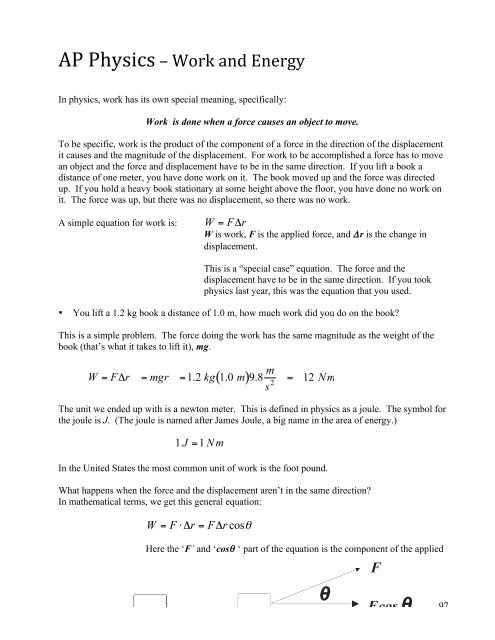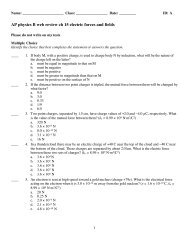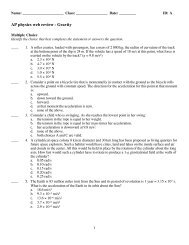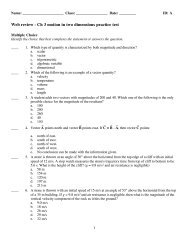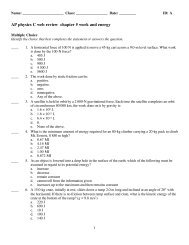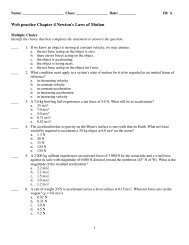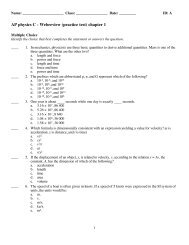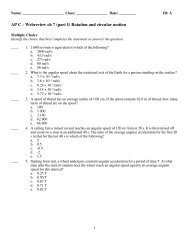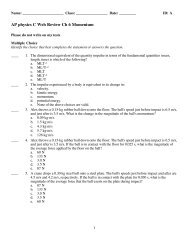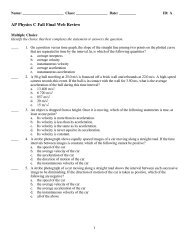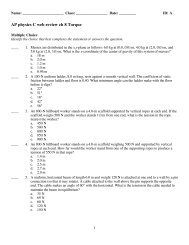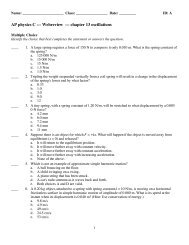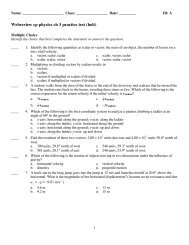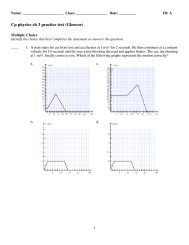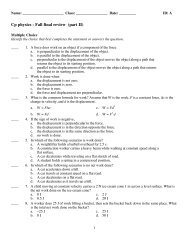AP Physics
AP Physics â Work and Energy - Planet Holloway
AP Physics â Work and Energy - Planet Holloway
You also want an ePaper? Increase the reach of your titles
YUMPU automatically turns print PDFs into web optimized ePapers that Google loves.
<strong>AP</strong> <strong>Physics</strong> – Work and Energy<br />
In physics, work has its own special meaning, specifically:<br />
Work is done when a force causes an object to move.<br />
To be specific, work is the product of the component of a force in the direction of the displacement<br />
it causes and the magnitude of the displacement. For work to be accomplished a force has to move<br />
an object and the force and displacement have to be in the same direction. If you lift a book a<br />
distance of one meter, you have done work on it. The book moved up and the force was directed<br />
up. If you hold a heavy book stationary at some height above the floor, you have done no work on<br />
it. The force was up, but there was no displacement, so there was no work.<br />
A simple equation for work is:<br />
W is work, F is the applied force, and Δr is the change in<br />
displacement.<br />
This is a “special case” equation. The force and the<br />
displacement have to be in the same direction. If you took<br />
physics last year, this was the equation that you used.<br />
• You lift a 1.2 kg book a distance of 1.0 m, how much work did you do on the book?<br />
This is a simple problem. The force doing the work has the same magnitude as the weight of the<br />
book (that’s what it takes to lift it), mg.<br />
The unit we ended up with is a newton meter. This is defined in physics as a joule. The symbol for<br />
the joule is J. (The joule is named after James Joule, a big name in the area of energy.)<br />
In the United States the most common unit of work is the foot pound.<br />
What happens when the force and the displacement aren’t in the same direction?<br />
In mathematical terms, we get this general equation:<br />
Here the ‘F’ and ‘cosθ ‘ part of the equation is the component of the applied<br />
97
force that is in the direction of the displacement.<br />
The drawing above represents the motion of a crate being moved by an applied force. The crate is<br />
moved a distance . The work done is simply<br />
We find this equation in its <strong>AP</strong> form as:<br />
Here is work, is the net force, is the distance the object is moved, and is<br />
the angle the net force makes with the direction of motion.<br />
It’s two equations in one. The first one is for when the angle is zero and the net<br />
force has the same direction as the motion. So we can say that<br />
The second one is used when there is an angle between the net force and the motion<br />
direction.<br />
• A force is applied to a crate at an angle of 25°. The crate is dragged across the deck a distance<br />
of 2.5 m. If the amount of work done after it has been moved is 1 210 J, what was the applied<br />
force?<br />
This is a simple problem, all we have to do is solve it for F!<br />
Work is a scalar quantity. This means you can add and subtract work without treating it as a<br />
vector. How convenient!<br />
Joules are a small unit, so it is very common to deal with kJ and MJ. A joule is roughly the amount<br />
of work you do when you lift a Big Mac one meter. That’s not very much work, is it?<br />
This brings us to the next exciting topic: energy!<br />
Energy: Energy is another one of those common terms that you hear all the time. Interestingly<br />
enough, in everyday language, it is used pretty much correctly. Hmmph. Imagine that.<br />
In physics we define energy as: Energy ≡ the ability to do work.<br />
But what does that mean? Well work is done when something is displaced by a force. If work is<br />
done, it takes energy. If you lift a 1 N rock 1 m, you’ve done 1 J of work and expended 1 J of<br />
energy.<br />
98
Energy and work, intimately related as they are, use the same unit.<br />
Energy comes in a vast array of types and all sorts of ways have been devised to classify the<br />
different types of energy. No doubt you can think of lots of them. There’s electrical energy, solar<br />
energy, nuclear energy, thermal energy, chemical energy, &tc. Lots of energy types.<br />
Initially we will be dealing with mechanical energy. This is the energy associated with motion and<br />
forces. There are two types of mechanical energy (these types can be applied - and often are – to<br />
all types of energy, keep in mind). The two types are kinetic energy and potential energy.<br />
Kinetic Energy: This is the energy of motion. When a system is moving, it has kinetic<br />
energy. Thus the object’s motion can be transformed into work. All this means is that a moving<br />
object can hit something and make it move, thus accomplishing work. The unit for kinetic energy is<br />
the joule. The equation for kinetic energy is:<br />
K stands for kinetic energy, m is the mass of the object, and v is its velocity.<br />
• How much kinetic energy does a 2.5 kg ball possess if it is thrown with a velocity of 21 m/s?<br />
Very simple problem, just use the equation.<br />
Can you see how the unit ends up being a joule?<br />
When an object is given kinetic energy (by applying a force to it, of course), the amount of work<br />
required to do this is, ignoring friction, equal to the kinetic energy the object gains.<br />
We can say this in a more fancy way. We say that the net work done on an object by a net force is<br />
equal to the change in its kinetic energy.<br />
If it starts at rest, then the K 0 term is zero and the net work is equal to the final kinetic energy.<br />
• A net 6 500 N force is applied to a resting 1 500 kg car, moving it forward. What is its kinetic<br />
energy and speed after being displaced 150 m?<br />
There are two equations we can use:<br />
The car begins at rest and the force is in the direction of the car’s motion. And<br />
99
First we calculate the amount of work the force does, this will give us the amount of kinetic energy<br />
the car ends up with. (Oh my, is that a dangling participle? The <strong>Physics</strong> Kahuna is not sure about<br />
that sort of thing. Just what the heck is a participle?)<br />
This is equal to the kinetic energy of the car at the end of the event. So<br />
Now to find the velocity. We can use the equation for kinetic energy, since we’ve calculated its<br />
value:<br />
Anything in motion has kinetic energy – falling water, the wind, moving electrons, &tc. We will<br />
find that analyzing an object’s kinetic energy is a very powerful weapon in the old physics problemsolving<br />
arsenal.<br />
Potential Energy: Potential energy is stored energy. There are many ways that energy can<br />
be stored. An electric battery represents stored energy, water piled up behind a dam, and chemical<br />
bonds in molecules to name just a few are also common ways to store energy. The type of potential<br />
energy that we will initially be interested in has to do with the energy of position brought about by<br />
gravity and by a spring being compressed or elongated.<br />
First let’s look at gravitational potential energy. When an object is lifted to a height above a<br />
reference frame, work is done and object gains potential energy. The energy it gains is equal<br />
(ignoring friction) to the work done on it. The standard form that the equation for potential energy<br />
of position takes is:<br />
although it’s usually written as simply:<br />
U is potential energy, m is the mass, g is the acceleration of gravity, and y is<br />
the vertical displacement.<br />
It is also very common to write it in a slightly different form as:<br />
100
Where<br />
displacement.<br />
(standing for height) simply means the vertical<br />
An object which is lifted to some new position can, if released from that position, do work as it falls<br />
back down. Old-fashioned clocks use weights in this way to power the clockwork mechanism.<br />
The net work done by falling object is simply the change in potential energy.<br />
When solving potential energy problems, the reference frame should be chosen to simplify the<br />
solution.<br />
One sets the bottom position as zero and then all other displacements are measured in reference to<br />
the zero position.<br />
• A 12 500 kg boulder is 157 m above a cabin. What is its PE with respect to the cabin?<br />
Conservation of Energy: One of the most important laws in all of science is the law of<br />
conservation of energy. In chemistry you probably looked at it in this form: energy can not be<br />
created or destroyed. In physics, we say:<br />
Energy is neither gained nor lost in any process.<br />
Energy can be transformed from one type to another, but, in any closed system the amount of<br />
energy cannot change.<br />
We can examine conservation of energy by dropping a rubber ball. The ball begins at some initial<br />
height – it therefore has a certain amount of potential energy. As it is not moving, it has no kinetic<br />
energy whatsoever. The ball is released and starts falling downward. As it falls it accelerates and<br />
falls faster and faster. This means that its kinetic energy is increasing as it falls. Its potential energy<br />
is decreasing because its height is becoming smaller. What is happening is that its potential energy<br />
is being converted into kinetic energy. Just before it hits, all of its potential energy will have been<br />
transformed into kinetic energy.<br />
But what happens when it hits?<br />
The ball deforms on contact; it gets squished. Its kinetic energy is being transformed into potential<br />
energy – the same kind of potential energy as you would find in a compressed spring or stretched<br />
rubber band. The ball then “unsquishes” itself (wow, the <strong>Physics</strong> Kahuna has invented a word!) and<br />
rebounds. The potential energy stored in the ball is transformed back into kinetic energy and the<br />
ball goes back up. On the bounce, this kinetic energy is converted back into potential energy as the<br />
101
all moves upward. When the ball stops, all of its kinetic energy has been transformed into<br />
potential energy, and so on.<br />
The interesting thing, and a point that makes one doubt the law of conservation of energy, is that the<br />
ball doesn’t bounce back to its original height. So the uninformed observer thinks, “Hey, energy<br />
got lost here! It didn’t go to the same height so some of its energy was destroyed! Hah! So much<br />
for the stupid law of conservation of energy!”<br />
Well, the law of conservation of energy always works – it is the law, after all. What happens is that<br />
the energy of the ball is transformed into energy forms that do not contribute to the bounce height.<br />
We call these transformations energy losses. They are not really energy losses, however, in the<br />
sense that energy has been destroyed.<br />
When the ball falls it encounters friction with the air. It must push aside air molecules, giving them<br />
some of its energy. The air molecules gain energy during the collisions with the ball as it falls and<br />
some of the molecules making up the ball also gain energy. The effect of this is to heat the air and<br />
the ball to slightly higher temperatures. This means that its kinetic energy is less than what is<br />
expected (but not by much, the decrease in energy for a ball falling a few meters on the surface of<br />
the earth is almost insignificant). The ball finally hits the deck. Most of its kinetic energy goes<br />
into making the ball deform. When the ball “undeforms itself” this energy is converted back into<br />
kinetic energy since the ball will be going up. The deformation, however, causes the individual<br />
molecules that make up the ball to gain energy - they vibrate more; the effect of this is to heat the<br />
ball. The energy that makes the ball’s particles vibrate more vigorously is no longer available as<br />
potential energy in the squished ball. The ball’s temperature increases. This means that the<br />
potential energy stored in the ball is less than the kinetic energy it began with before the squish.<br />
The deck under the ball is also distorted and heated slightly.<br />
The ball also produces a noise when it hits, this is another energy loss. Energy is also lost to<br />
friction with the air as it rises after the bounce. The effect of these energy losses is that the ball<br />
doesn’t bounce as high as the place from whence it came.<br />
If we total up the sum of all the energies and energy transformations that occurred during the ball<br />
drop event (the frictional heating, the deformational heating, the<br />
sound produced, &tc.), however, we would find that the final<br />
sum of energy is equal to the initial amount of energy.<br />
One of the demonstrations we did was one with a bowling ball,<br />
the one where it swung back and forth. Remember? A bowling<br />
ball was hung from a line that was secured to a hook in the<br />
ceiling. The ball was swung like a big pendulum.<br />
Looking at the drawing of the ball’s path to the right, where does<br />
the ball have maximum/minimum kinetic energy and where does<br />
it have maximum/minimum potential energy?<br />
Point A represents the maximum deflection to the left, point B<br />
represents the lowest point in the path, and point C represents the<br />
maximum deflection to the right.<br />
102
At point A the ball is held at rest. All of its energy is potential energy because of its height y above<br />
the lowest point of travel.<br />
The ball is released and its potential energy is converted into<br />
kinetic energy. At point B, the lowest point in its path, all of<br />
the energy will be kinetic energy. With respect to point B,<br />
chosen as our zero point, it has no potential energy (although<br />
it does have potential energy with respect to the deck below,<br />
but the rope won’t let it fall). As it rises to reach point C the kinetic energy is converted into<br />
potential energy. At point C all of its energy is potential. As the ball swings back and forth, the<br />
energy is transformed continually from potential energy to kinetic energy and so on.<br />
Of course energy is converted into other forms besides potential and kinetic energy, so the ball will<br />
eventually come to rest. Each swing of the ball will end up at a slightly lower position until the ball<br />
stops moving. This is why the brave student could release the ball from a position where it was<br />
touching her nose and be absolutely confident that it would not come back and smash in her teeth.<br />
The ball had to obey that laws of physics, didn’t it.<br />
This is, if you think about it, mind-boggling.<br />
The law of conservation of energy was developed during the 1800’s. It is<br />
credited to Hermann von Helmholtz, although most of the work was done<br />
by James Joule. Turned out that nobody believed Joule (he was of the<br />
lower class and did not have a great deal of prestige at the time) but von<br />
Helmholtz had a grand reputation – he had the “von” thing going with his<br />
name, see, and so physicists believed him and gave him the credit. Joule<br />
got the final victory, however, there is no unit named the”von<br />
Helmholtz”.<br />
Anyway, the implication of the law is really profound. It’s easy to accept<br />
that the energy of a small isolated system is constant, but what about the<br />
universe? The universe is an isolated system, ain’t it? You bet it is.<br />
This means that the total energy within the universe is unchanging. The<br />
universe began with “x” amount of energy around 15 billion years ago<br />
and today, it still has that same amount of energy.<br />
This means that for 15 billion years the universe’s energy has been busy plugging away changing<br />
from one form to another. Will it ever get tired of doing this?<br />
Using the Law of Conservation of Energy:<br />
The energy in an isolated system can’t change. This is powerful stuff.<br />
Energy Before = Energy After or E = E'<br />
(The little apostrophe mark added to the E making it E' means the quantity after some event.<br />
We pronounce E’ as “E prime”.)<br />
103
Let us look at a simple example. A rock is held at some height y above the deck. The rock is<br />
dropped and falls. We examine the energy before and the energy after and, thanks to the law,<br />
determine that the two quantities must equal each other. Let us note that we are ignoring all other<br />
energy losses, which is reasonable for this sort of event. Very little energy is lost by the rock as it<br />
falls a few meters.<br />
The energy before (prior to being dropped) is:<br />
The energy after (just before the rock hits) is:<br />
Using these two relationships, we can write a general equation for the example.<br />
In general, without knowing the specifics, we can write the following equation:<br />
This simply means that the energy before is the sum of its initial kinetic energy and potential<br />
energy. The energy after the event is the sum of its final kinetic and potential energy.<br />
• A 1.5 kg ball is dropped from a height of 2.3 m. What is its speed the instant before it strikes<br />
the deck?<br />
This problem could be solved using the acceleration equations that we’ve already learned about, but<br />
it can also be solved quite easily using the law of conservation of energy.<br />
We can assume that the ball’s potential energy at the top will equal its kinetic energy just before it<br />
hits.<br />
Thus,<br />
The ball has no initial kinetic energy and no final potential energy, so the equation can be<br />
simplified by dropping out their terms. We can also eliminate the little subscript thingees.<br />
Solve for the speed. Also note that the masses cancel out on each side.<br />
104
• A 500.0 g ball is thrown straight upward with a velocity of 35.4 m/s. How high does it go?<br />
Use the law of conservation of energy. Rather than write out all the terms of the energy equation,<br />
we’ll just use the parts that apply.<br />
solve for y.<br />
These problems are quite simple. The conservation of energy can also be used to solve some really<br />
complicated problems.<br />
A roller coaster train is at rest at the top of a hill, the brakes are released and it rolls down some sort<br />
of a curved slope. What will be its speed at the bottom of the hill?<br />
This seems to be a very complicated problem. The train will not be accelerating at because it’s<br />
going down a ramp. It isn’t even a straight ramp, they usually curve, so how can you find its speed?<br />
Conservation of energy! The energy at the top equals the energy at the bottom! (Ignoring friction<br />
of course.)<br />
• A roller coaster pauses at the top of a 75 m hill. What will be its speed at the bottom of the hill?<br />
• The first hill on a roller coaster is 94 m tall, the second hill is 68 m tall. If it starts from rest on<br />
the first hill, what theoretical speed will the roller coaster have on the second hill?<br />
The train has only potential energy at the top of the first hill, but it has both potential<br />
and kinetic energy at the top of the second hill. This is because it is moving and is<br />
not at the bottom of the system at zero vertical displacement.<br />
105
Let’s complicate things a bit more.<br />
• A 655 N diver leaps into the water from a height of 10.0 m. What<br />
is his speed 2.00 m above the water?<br />
An even simpler method was to have your zero displacement position be 2.00 meters above the<br />
surface of the water, then the energy equation would be:<br />
• A sled and rider together have a mass of 87 kg. They are atop a hill elevated at 42.5°. They<br />
slide down the slope a distance of 35 m and reach the bottom. Find the speed at the bottom of<br />
hill. Assume no friction.<br />
The simplest way to solve the problem is to use<br />
conservation of energy.<br />
We need to calculate the<br />
height.<br />
106
107


